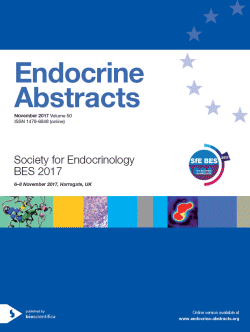Searchable abstracts of presentations at key conferences in endocrinology

Society for Endocrinology BES 2017
Harrogate,
UK
06 Nov 2017 - 08 Nov 2017

SfE BES 2017 will be on the 6-8 November 2016 in Harrogate, UK.
Clinical Management Workshops
Workshop 5: How do I. . . (2)
ea0050cmw5.1 | Workshop 5: How do I. . . (2) | SFEBES2017
How do I follow up a patient with an indeterminate non-functioning adrenal nodule?
Incidentally discovered adrenal nodules are an increasingly common reason for referral into the endocrine clinic. Assessment includes a hormonal work-up to look for endocrine function, and reviewing the size and radiological characteristics of the lesion. Some nodules have benign radiological features (less than 10 HU on an unenhanced CT scan), whilst others are radiologically indeterminate (more than 10 HU). We worry about missing a malignant process. The research data and in...
ea0050cmw5.2 | Workshop 5: How do I. . . (2) | SFEBES2017
How do I manage a postmenopausal woman asking for testosterone replacement
Oestrogens are formed in the ovary from androgen precursors which circulate at a higher concentration in the blood and have a greater production and secretion rate than oestrogens. Although the post menopausal ovary remains a source of testosterone (T) production there is a fall in total circulating androgens with age and this results from a combination of ovarian failure, decreasing adrenal secretion and peripheral conversion.This relative androgen deficiency is greater in wo...
ea0050cmw5.3 | Workshop 5: How do I. . . (2) | SFEBES2017
How do I ... approach CVS surveillance in a patient with Turner Syndrome
New international clinical guidelines have just been published, based on an international effort that started with exploratory meetings in 2014 in both Europe and the USA, and culminated with a Consensus Meeting held in Cincinnati, Ohio, USA in July 2016. These guidelines were initiated and developed by ESE in Europe, and by PES in USA, with important contributions from ESHRE, Endocrine Society, ESC, AHA, Society for Endocrinology, and ESPE.Morbidity and...
ea0050cmw5.4 | Workshop 5: How do I. . . (2) | SFEBES2017
How do I manage Adipsic Diabetes Insipidus
Maintenance of serum sodium and water balance is a key feature of normal physiology; mediated through the regulation of water intake and renal water loss. Adipsic and hypodipsic disorders are characterized by inadequate spontaneous fluid intake due to defects in osmo-regulated thirst. Patients deny thirst and do not drink, despite dehydration and hypovolaemia. The hypothalamic osmoregulation of thirst and Vasopressin (AVP) production are functionally linked, though anatomicall...
ea0050cmw5.5 | Workshop 5: How do I. . . (2) | SFEBES2017
How do I manage hypercalcaemia during pregnancy?
Hypercalcaemia due to primary hyperparathyroidism during pregnancy may be associated with maternal and foetal complications as well as neonatal tetany. Asymptomatic women with mild hypercalcaemia may be managed conservatively. Symptomatic patients or those with severe hypercalcaemia should be offered parathyroidectomy in the second trimester. This session will summarise the current practice in the management of patients with hypercalcaemia during pregnancy at Hammersmith Hospi...
ea0050cmw5.6 | Workshop 5: How do I. . . (2) | SFEBES2017
How do I manage.... myxoedema coma
Myxoedema coma is a rare endocrine emergency with reported high mortality. Exact incidence is hampered by no clear consensus on its definition and the huge variability in its presentation. Most patients are not comatose, and have a form of severe, decompensated hypothyroidism. The common clinical features, including poor mentation, hypothermia, haemodynamic instability and lethargy, correlate poorly to degree of biochemical hypothyroidism. Early detection and identifying commo...



